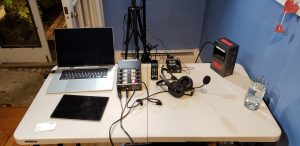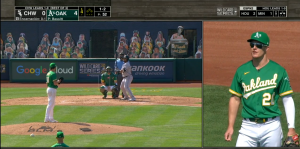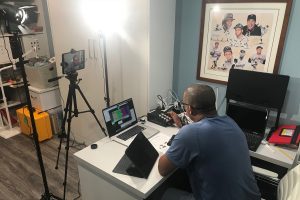ESPN’s ‘Live From Home’ Model Continues To Pay Dividends During MLB Wild Card Series
In-game interviews are made possible by remote-commentary systems
Story Highlights
Anyone looking to see just how far remote production has come over the past six months needs only to look at ESPN’s coverage of Game 2 of the Oakland A’s–Chicago White Sox MLB Wild Card series on Sept. 30. In the top of the 4th inning, ESPN play-by-play caller Dave Flemming and analyst Jessica Mendoza – both of whom were hundreds of miles away from the ballpark – conducted a live in-game interview with A’s outfielder Mark Canha as he manned left field.
"That was executed to perfection on my part" – @outtadapakmark with a legendary in-game interview about his catch 😂 pic.twitter.com/wOTpo4TIBd
— The Rickey Henderson of Blogs (@RickeyBlog) September 30, 2020
An Interstate In-Game Interview
In-game interviews have never been an easy proposition: they are awkward exchanges or are riddled with delays. Although more players have been miked up this MLB season, these in-game interviews have been further complicated since ESPN produced the its MLB broadcasts remotely this year.
During the A’s–White Sox game, Flemming was in Charlotte, NC; Mendoza was in Oregon; Canha was in Oakland; and the production team was in Bristol, CT. Despite the geographic challenges, the three on the ESPN team were able to carry on a conversation with no noticeable delay or technical issues.
“It’s pretty significant what has been achieved on the technical side in [ESPN facilities in] both Bristol and Charlotte,” says Orlins. “It’s pretty significant what they have to do to put all the pieces together.”
A Wild Ride: From KBO to MLB Wild Card
In early May, ESPN began live English-language broadcasts of Korea’s KBO League, one of the first professional sports leagues to return to play after the pandemic hit. The deal came together quickly, which meant that ESPN’s operations team had to come up with a remote-commentary solution for its announcers in less than a week. ESPN took what it had learned in delivering remote commentary on international events like World Cup and EUROs and created a Live From Home system that has flourished throughout the MLB season.
Continuing to evolve, the Live From Home remote-commentary kits rely on a Unity-based intercom system featuring a Dante-based Glensound Inferno commentary box connected to a MacBook Pro via a Dante Virtual Sound (DVS) card. Using the Unity Connect app, the system has seven bidirectional channels plus capability for the two on-air talent to have real-time comms with each other, with the producer/director in the control room in Bristol, and with members of the ESPN Research team at their homes. ESPN is also using Zoom teleconferencing on the MacBook to enable the talent to see each other and the production team during the live broadcast.
Kits have been deployed to ESPN commentators Karl Ravech, Jon Sciambi, Eduardo Perez, Jessica Mendoza, Kyle Peterson, and dozens of others for MLB game coverage and other ESPN telecasts.
“The key to creating an uncompromised entertainment experience was developing an environment where the talent could react to each other without any delay,” says Phil Orlins, senior coordinating producer, MLB, ESPN. “Not just a delay the audience didn’t notice, but a delay that [the participants] didn’t notice themselves. The development of the Live From Home commentary system made this a reality.”
Keeping in Touch: Unity and Zoom Play Key Role
These systems leverage the Unity intercom system and Zoom video conferencing to keep the talent in contact with one another and with the production. Working with Unity for audio allowed the commentary to travel in real time — well under 1/10th of a second — and seeing the production from Bristol on Zoom allowed commentators to see the game with only a 1/5th-second delay. Zoom also allowed the commentators to see and react to each other as part of the Zoom experience and allowed ESPN’s statisticians to provide notes on the Chat function on Zoom.

ESPN commentator Karl Ravech’s remote commentary setup at his home for KBO League baseball (Photo: Karl Ravech/ESPN)
“Once we were able to establish a real-time working environment for remote talent,” says Orlins, “the rest of the workflow with Bristol as the production hub came together seamlessly. Even for postseason, we were essentially re-creating this same workflow by producing our own world feeds from site and using Bristol as the production hub for talent, graphics, and highlights.”
CLICK HERE for more on ESPN’s REMI workflows and network operations.


